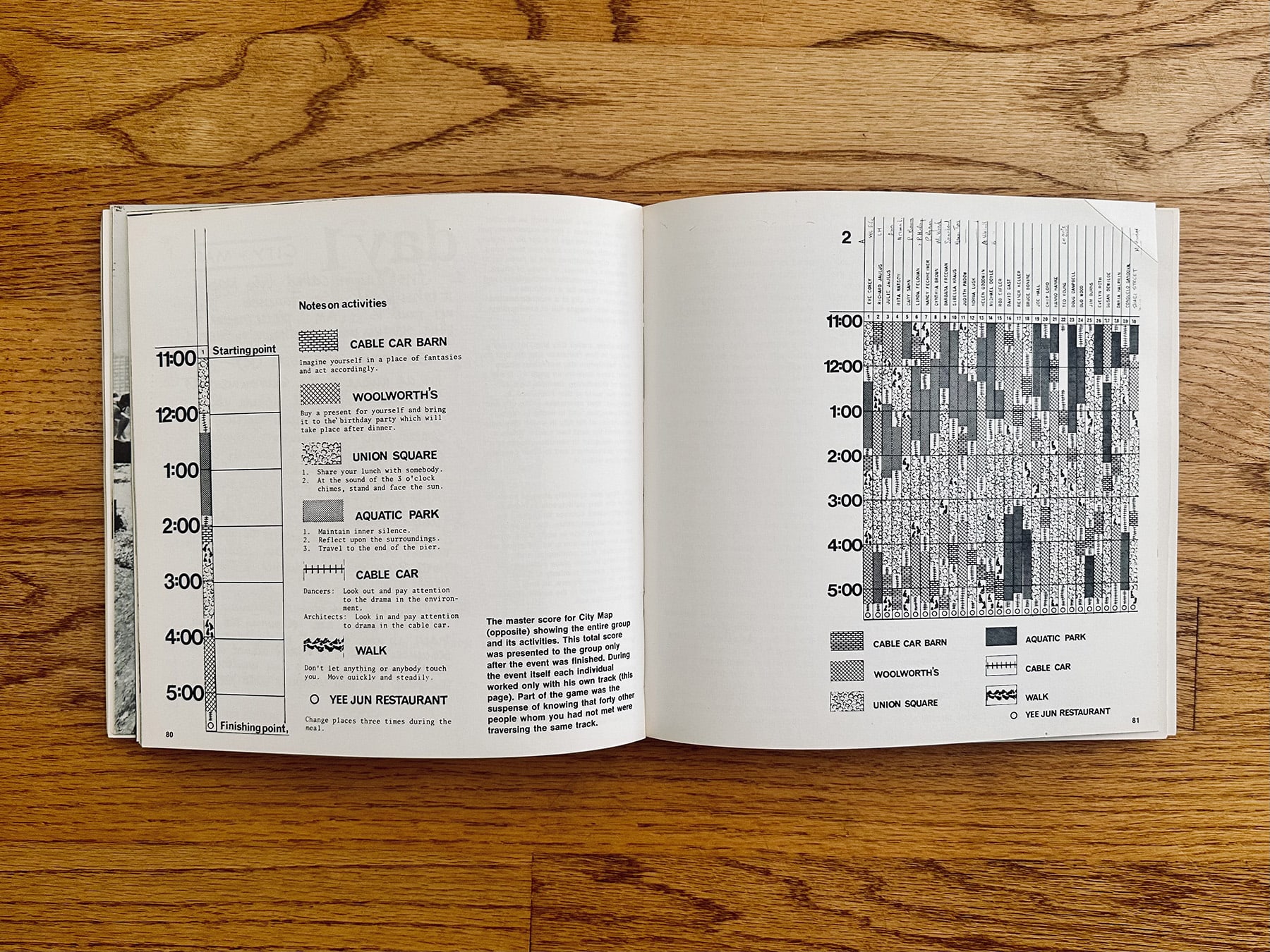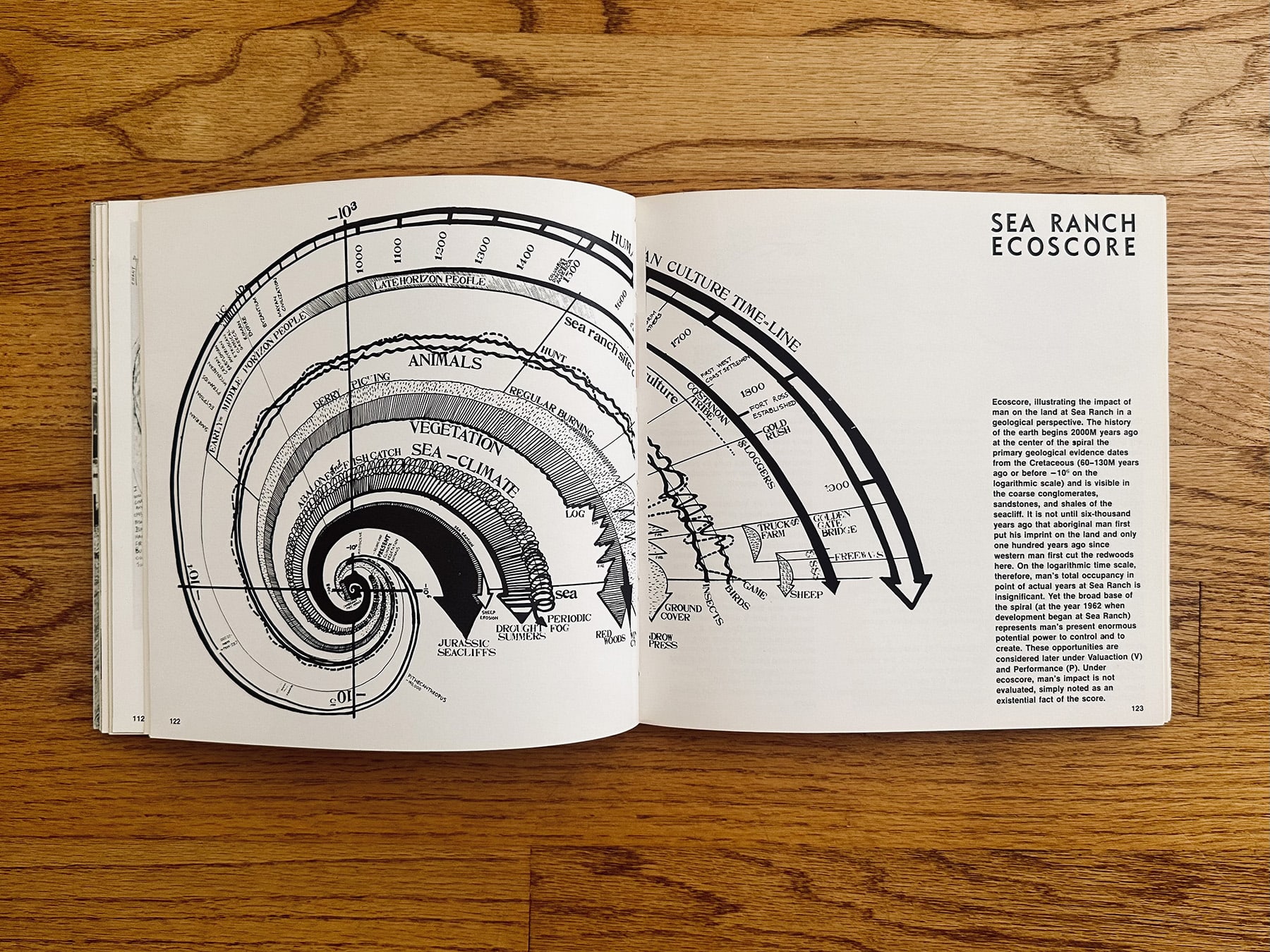The RSVP Cycles
When a book is referenced twice, from two different people in two different places, in the same week, I know I need to buy it immediately. That’s why Lawrence Halprin’s The RSVP Cycles: Creative Processes in the Human Environment arrived on my doorstep last week. I was vaguely aware of Halprin before; he’s a figure who very much fits within my interests: a polymathic landscape architect, artist, teacher, and theorist who often collaborated with his wife, choreographer and dancer Anna Halprin.
Halprin is probably best known for his master plan for Sea Ranch, the residential community located on a ten-mile stretch along the California coast 100 miles north of San Francisco, where Halprin lived. I didn’t know how much I encountered Halprin’s work, however, when I lived in San Francisco. Many of the public places I walked through hundreds of times: Justin Herman Plaza, Ghiradelli Square, Market Street, and United Nations Plaza, the last of which was two blocks from my own small apartment. I walked through it every day to get to work. What’s more, when The RSVP Cycles arrived on my porch, Barbara Stauffacher Solomon had just died, who worked with Halprin on the supergraphics at Sea Ranch. I was pleasantly surprised to see she also designed The RSVP Cycles book.

It’s in The RSVP Cycles, that Halprin laid out the theory and process that drove all his work. RSVP stands for Resources, Score, Valuaction, and Performance that when put together, create a creative cycle for collaboration and improvisation. Here is a short video of Halprin explaining the principles of the RSVP cycle from 2003:
“For me, professionally, the significance of the RSVP cycles lies in the fact that as an ecological designer I have always been interested in pluralism and the generative force of many contributions to solutions,” Halprin writes in the introduction. “I view the earth and its life processes as a model for the creative process, where not one but many forces interact with each other with results emergent-not imposed. I see the earth as a vast and intricately interrelated ecosystem. In this system all of the parts have value, and they are all moving toward balance.”
Resources is about examining and working with what is available for the process, whether that be time, idea, materials, or people. The Score is the instruction for the work; which we’ll come back to in a second. Valuaction, a word Halprin made up, combining Value and Action, is about feedback, understanding what is work and what is not based on the values determined in the project. Lastly, Performance, is about setting the work in motion, putting it out into the world.


The most important part of the RSVP cycle, and the part Halprin spends the most time for in the book, is scoring. Drawn from the musical scoring, Halprin writes that scores are not systems or rules but rather structures and platforms that allow for others to join into the process. He writes:
It is through them that we can involve ourselves creatively in “doing,” from which, in fact, structure emerges-the form of anything is latent in the process. The score is the mechanism which allows us all to become involved, to make our presence felt. Scores are process-oriented, not thing-oriented. In dance and theatre this works through open scoring, which establishes “lines of action” to which each person contributes and from which a final performance then emerges. In personal relations scoring allows a constant interaction devoid of the moralisms and shoulds and shouldn’ts which inhibit growth and deep contacts and involvements. In the planning of communities a score visible to all the people allows each one of us to respond, to tind our own input, to influence belore the performance is fixed, betore decisions are made. Scoring makes the process visible. For that reason scores seem to me the key link in the entire RSVP cycles-though only one link, still at the core of the whole procedure.
He continues:
The essential quality of a score is that it is a system of symbols which can convey, or guide, or control (as you wish), the interactions between elements such as space, time, rhythm, and sequences, people and their activities and the combinations which result from them. Not all scores invoke all of these elements-scores vary as to what they can or are intended to control. The characteristics of the type of score as a potential controlling or communicative device is a function of the particular art form and its inherent limitations. It also has a great deal to do with the attitudes and intentions of the scoring artist. Scores have been a means of recording past events, of prognosticating the future, and of influencing the present.
What emerges here is an early understanding of what we now call human-centered design. Halprin is essentially trying to create a design process that involves both human partipation while also accounting for durational work; an understanding that a project is never quite finished. “Perhaps my role is being redefined. I am coming to see the artist in another light. He is no longer a solitary hero figure, but rather a synthesizer who brings together differences and works to evoke the art within us all,” Halprin quotes his wife Anne. “This is the true meaning of a seminal theatre.”

The power of scores, for Halprin, is that it makes the process visible and in making the process visible, it allows anyone to participate, to add to, to feel empowered.
The new scoring needs to be as visible as possible so as to scatter power, destroy secrecy, and involve everyone in the process of evolving their own communities. Power is a responsibility, so the audience as participator (that means all elements of society in the broadest sense), when given power, needs an understanding of what this means to itself as well as to the distributor of power. It is no easier to accept power and use it with responsibility and love than it is to relinquish it.
The book is pulsing with energy. The bold three-column Helvetica-set text remind me of the energy in Marshall McLuhan’s books which marry text and image. It filled with diagrams, drawings, sketches, and photographs that illustrate these ideas and show examples of how scoring has been used in Halprin’s projects. It’s a book I already know I’ll be returning to again and again.
